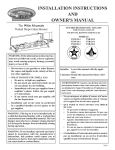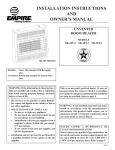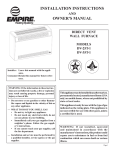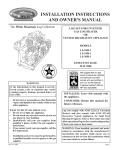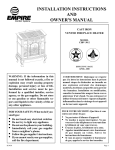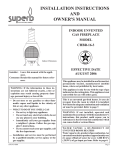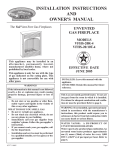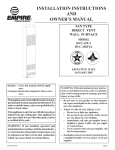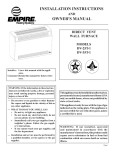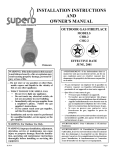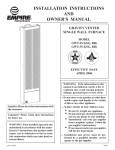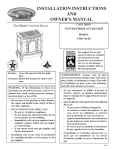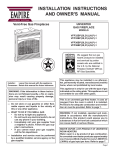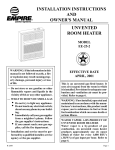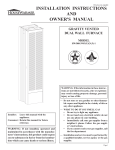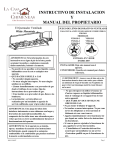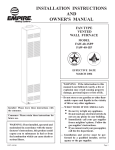Download Empire Comfort Systems VFCT25-3 User's Manual
Transcript
INSTALLATION INSTRUCTIONS AND OWNER'S MANUAL CAST IRON UNVENTED ROOM HEATER MODELS VFCM-25-3 VFCR-25-3 VFCT-25-3 Thisappliancemaybeinstalledinanaftermarket, permanently located, manufactured (mobile) home, where not prohibited by local codes. This appliance is only for use with the type of gas indicated on the rating plate. This appliance is not convertible for use with other gases. WARNING: If the information in these instructions are not followed exactly, a fire or explosion may result causing property damage, personal injury or loss of life. — Do not store or use gasoline or other flammable vapors and liquids in the vicinity of this or any other appliance. — WHAT TO DO IF YOU SMELL GAS • Do not try to light any appliance. • Do not touch any electrical switch; do not use any phone in your building. • Immediately call your gas supplier from a neighbor’s phone. Follow the gas supplier’s instructions. • If you cannot reach your gas supplier, call the fire department. — Installation and service must be performed by a qualified installer, service agency or the gas supplier. 16937-4-0806 EFFECTIVE DATE AUGUST 2006 Installer: Leave this manual with the appliance. Consumer: Retain this manual for future reference. This is an unvented gas-fired heater. It uses air (oxygen) from the room in which it is installed. Provisions for adequate combustion and ventilation air must be provided. Refer to page 6. WARNING: If not installed, operated and maintained in accordance with the manufacturer's instructions, this product could expose you to substances in fuel or from fuel combustion which can cause death or serious illness. WATER VAPOR: A BY-PRODUCT OF UNVENTED ROOM HEATERS Water vapor is a by-product of gas combustion. An unvented room heater produces approximately one (1) ounce (30ml) of water for every 1,000 BTU's (.3KW's) of gas input per hour. Refer to page 6. Page 1 TABLE OF CONTENTS SECTION PAGE Important Safety Information ....................................................................................................................................................... 3 Safety Information for Users of LP Gas ....................................................................................................................................... 4 Introduction................................................................................................................................................................................... 5 Specifications ................................................................................................................................................................................ 5 Water Vapor: A By-Product of Unvented Room Heaters ............................................................................................................. 6 Provisions for Adequate Combustion and Ventilation Air ............................................................................................................ 6 Gas Supply .................................................................................................................................................................................... 7 Clearances .................................................................................................................................................................................... 8 Assembly of Cast Iron (Outer Casing) Stove Casting .............................................................................................................. 8-9 Log Placement ........................................................................................................................................................................... 10 Placement of Glowing Embers ................................................................................................................................................... 10 Important Guidelines .................................................................................................................................................................. 11 VFCR-25, VFCT-25 Photos........................................................................................................................................................ 12 Operation Instructions/Flame Appearance ................................................................................................................................. 13 VFCM-25 Lighting Instructions ................................................................................................................................................ 14 VFCR-25 Lighting Instructions ................................................................................................................................................. 15 VFCT-25 Lighting Instructions ................................................................................................................................................. 16 Pilot Flame Characteristics .................................................................................................................................................... 17-18 Wiring ........................................................................................................................................................................................ 18 Millivolt Operating Instructions ................................................................................................................................................. 19 Operating Guidelines .................................................................................................................................................................. 20 Maintenance ................................................................................................................................................................................ 20 Troubleshooting ........................................................................................................................................................................ 21 Parts List ..................................................................................................................................................................................... 22 Parts View .................................................................................................................................................................................. 23 How to Order Repair Parts ......................................................................................................................................................... 23 Service Notes .............................................................................................................................................................................. 24 Page 2 16937-4-0806 IMPORTANT SAFETY INFORMATION THIS IS A HEATING APPLIANCE DO NOT OPERATE THIS APPLIANCE WITHOUT FRONT PANEL INSTALLED. • An unvented room heater having an input rating of more than 6,000 Btu per hour shall not be installed in a bathroom. • An unvented room heater having an input rating of more than 10,000 Btu per hour shall not be installed in a bedroom or bathroom. • Due to high temperatures, the appliance should be located out of traffic and away from furniture and draperies. • Children and adults should be alerted to the hazard of high surface temperature and should stay away to avoid burns or clothing ignition. • DO NOT use this room heater if any part has been under water. Immediately call a qualified service technician to inspect the room heater and to replace any part of the control system and any gas control which has been under water. • Due to high surface temperatures, keep children, clothing and furniture away. • Under no circumstances should any solid fuels (wood, coal, paper or cardboard etc.) be used in this appliance. • The flow of combustion and ventilation air must not be obstructed in any way. • Young children should be carefully supervised when they are in the same room with the appliance. • Keep appliance area clear and free from combustible materials, gasoline and other flammable vapors and liquids. • Do not place clothing or other flammable material on or near the appliance. • WARNING: Do not use a blower insert, heat exchanger insert or other accessory not approved for use with this heater. • WARNING: This appliance is equipped for (natural gas or propane) gas. Field conversion is not permitted. • Keep burner and control compartment clean. • Installation and repair should be done by a QUALIFIED SERVICE PERSON. The appliance should be inspected before use and at least annually by a professional service person. More frequent cleaning may be required due to excessive lint from carpeting, bedding materials, etc. It is imperative that control compartments, burners and circulating air passageways of the appliance be kept clean. • DO make a periodic visual check of pilot and burners. Clean and replace damaged parts. WARNING When used without adequate combustion and ventilation air, heater may give off CARBON MONOXIDE, an odorless, poisonous gas. Do not install heater until all necessary provisions are made for combustion and ventilation air. Consult the written instructions provided with the heater for information concerning combustion and ventilation air. In the absence of instructions, refer to the National Fuel Gas Code, ANSI Z223.1, Section 5.3 or applicable local codes. This heater is equipped with a PILOT LIGHT SAFETY SYSTEM designed to turn off the heater if not enough fresh air is available. DO NOT TAMPER WITH PILOT LIGHT SAFETY SYSTEM! If heater shuts off, do not relight until you provide fresh air. If heater keeps shutting off, have it serviced. Keep burner and control compartment clean. 16937-4-0806 CARBON MONOXIDE POISONING MAY LEAD TO DEATH. Early signs of carbon monoxide poisoning resemble the flu, with headache, dizziness and/or nausea. If you have these signs, heater may not be working properly. Get fresh air at once! Have heater serviced. Some people — pregnant women, persons with heart or lung disease, anemia, those under the influence of alcohol, those at high altitudes — are more affected by carbon monoxide than others. The pilot light safety system senses the depletion of oxygen at its location. If this heater is installed in a structure having a high vertical dimension, the possibility exists that the oxygen supply at the higher levels will be less than that at the heater. In this type of application, a fan to circulate the structure air will minimize this effect. The use of this fan will also improve the comfort level in the structure. When a fan is used to circulate air, it should be located so that the air flow is not directed at the burner. Page 3 SAFETY INFORMATION FOR USERS OF LP-GAS Propane (LP-Gas) is a flammable gas which can cause fires and explosions. In its natural state, propane is odorless and colorless. You may not know all the following safety precautions which can protect both you and your family from an accident. Read them carefully now, then review them point by point with the members of your household. Someday when there may not be a minute to lose, everyone's safety will depend on knowing exactly what to do. If, after reading the following information, you feel you still need more information, please contact your gas supplier. LP-GAS WARNING ODOR If a gas leak happens, you should be able to smell the gas because of the odorant put in the LP-Gas. That's your signal to go into immediate action! Do not operate electric switches, light matches, use your • Use your neighbor's phone and call a trained LP-Gas service phone. Do not do anything that could ignite the gas. person and the fire department. Even though you may not Get everyone out of the building, vehicle, trailer, or area. continue to smell gas, do not turn on the gas again. Do not Do that IMMEDIATELY. re-enter the building, vehicle, trailer, or area. Close all gas tank or cylinder supply valves. • Finally, let the service man and firefighters check for escaped LP-Gas is heavier than air and may settle in low areas such gas. Have them air out the area before you return. Properly as basements. When you have reason to suspect a gas leak, trained LP-Gas service people should repair the leak, then keep out of basements and other low areas. Stay out until check and relight the gas appliance for you. firefighters declare them to be safe. • • • • NO ODOR DETECTED - ODOR FADE Some people cannot smell well. Some people cannot smell the odor of the chemical put into the gas. You must find out if you can smell the odorant in propane. Smoking can decrease your ability to smell. Being around an odor for a time can affect your sensitivity or ability to detect that odor. Sometimes other odors in the area mask the gas odor. People may not smell the gas odor or their minds are on something else. Thinking about smelling a gas odor can make it easier to smell. The odorant in LP-gas is colorless, and it can fade under some circumstances. For example, if there is an underground leak, the movement of the gas through soil can filter the odorant. Odorants in LP-Gas also are subject to oxidation. This fading can occur if there is rust inside the storage tank or in iron gas pipes. The odorant in escaped gas can adsorb or absorb onto or into walls, masonry and other materials and fabrics in a room. That will take some of the odorant out of the gas, reducing its odor intensity. LP-Gas may stratify in a closed area, and the odor intensity could vary at different levels. Since it is heavier than air, there may be more odor at lower levels. Always be sensitive to the slightest gas odor. If you detect any odor, treat it as a serious leak. Immediately go into action as instructed earlier. SOME POINTS TO REMEMBER • Learn to recognize the odor of LP-gas. Your local LP-Gas Dealer can give you a "Scratch and Sniff" pamphlet. Use it to find out what the propane odor smells like. If you suspect that your LP-Gas has a weak or abnormal odor, call your LP-Gas Dealer. • If you are not qualified, do not light pilot lights, perform service, or make adjustments to appliances on the LP-Gas system. If you are qualified, consciously think about the odor of LP-Gas prior to and while lighting pilot lights or performing service or making adjustments. • Sometimes a basement or a closed-up house has a musty smell that can cover up the LP-Gas odor. Do not try to light pilot lights, perform service, or make adjustments in an area where the conditions are such that you may not detect the odor if there has been a leak of LP-Gas. • Odor fade, due to oxidation by rust or adsorption on walls of new cylinders and tanks, is possible. Therefore, people should be particularly alert and careful when new tanks or cylinders are placed in service. Odor fade can occur in new tanks, or reinstalled old tanks, if they are filled and allowed Page 4 to set too long before refilling. Cylinders and tanks which have been out of service for a time may develop internal rust which will cause odor fade. If such conditions are suspected to exist, a periodic sniff test of the gas is advisable. If you have any question about the gas odor, call your LP-gas dealer. A periodic sniff test of the LP-gas is a good safety measure under any condition. • If, at any time, you do not smell the LP-Gas odorant and you think you should, assume you have a leak. Then take the same immediate action recommended above for the occasion when you do detect the odorized LP-Gas. • If you experience a complete "gas out," (the container is under no vapor pressure), turn the tank valve off immediately. If the container valve is left on, the container may draw in some air through openings such as pilot light orifices. If this occurs, some new internal rusting could occur. If the valve is left open, then treat the container as a new tank. Always be sure your container is under vapor pressure by turning it off at the container before it goes completely empty or having it refilled before it is completely empty. 16937-4-0806 INTRODUCTION Instructions to Installer 1. Installer must leave instruction manual with owner after installation. 2. Installer must have owner fill out and mail warranty card supplied with unvented room heater. 3. Installer should show owner how to start and operate unvented room heater. Always consult your local Building Department regarding regulations, codes or ordinances which apply to the installation of an unvented room heater. This appliance may be installed in an aftermarket* permanently located, manufactured (mobile) home, where not prohibited by state or local codes. *Aftermarket: Completion of sale, not for purpose of resale, from the manufacturer. This appliance is only for use with the type of gas indicated on the rating plate. WARNING: ANY CHANGE TO THIS HEATER OR ITS CONTROLS CAN BE DANGEROUS. Any safety screen or guard removed for servicing an appliance must be replaced prior to operating the heater. General Information This unvented heater is design certified in accordance with American National Standards Institute Z21.11.2 by the Canadian Standards Association as an Unvented Room Heater and should be installed according to these instructions. Attention: During initial use of ceramic log you will detect an odor as the ceramic log is cured. Also, during the curing process the ceramic log will burn with a yellow flame. Any alteration of the original design, installed other than as shown in these instructions or use with a type of gas not shown on the rating plate is the responsibility of the person and company making the change. Important All correspondence should refer to complete Model Number, Serial Number and type of gas. BRUCE SPECIAL COPY Notice: During initial firing of this unit, its paint will bake out, and smoke will occur. To prevent triggering of smoke alarms, ventilate the room in which the unit is installed. Qualified Installing Agency Installation and replacement of gas piping, gas utilization equipment or accessories and repair and servicing of equipment shall be performed only by a qualified agency. The term "qualified agency" means any individual, firm, corporation or company which either in person or through a representative is engaged in and is responsible for (a) the installation or replacement of gas piping or (b) the connection, installation, repair or servicing of equipment, who is experienced in such work, familiar with all precautions required and has complied with all the requirements of the authority having jurisdiction. State of Massachusetts: The installation must be made by a licensed plumber or gas fitter in the Commonwealth of Massachusetts. Sellers of unvented propane or natural gas-fired supplemental room heaters shall provide to each purchaser a copy of 527 CMR 30 upon sale of the unit. The installation must conform with local codes or, in the absence of local codes, with the National Fuel Gas Code, ANSI Z223.1/ NFPA 54.* *Available from the American National Standards Institute, Inc., 11 West 42nd St., New York, N.Y. 10036. High Altitudes For altitudes/elevations above 2,000 feet (610m), ratings should be reduced at the rate of 4 percent for each 1,000 feet (305m) above sea level. Contact the manufacturer or your gas company before changing spud/orifice size. Well Head Gas Installations Some natural gas utilities use "well head" gas. This may affect the Btu output of the unit. Contact the gas company for the heating value. Contact the manufacturer or your gas company before changing spud/orifice size. WARNING: Failure to keep the primary air opening(s) of the burner(s) clean may result in sooting and property damage. SPECIFICATIONS Model VFCR-25 VFCM-25 Input BTU/HR (KW/H) Max. (LP/NAT) 25,000 ( 7.3) 25,000 (7.3) Medium —— 20,000 (5.9) Min. (LP/NAT) 17,500 (5.1) 15,000 (4.4) Height 26 3/4" (679mm) 26 3/4" (679mm) Width 26 1/4" (666mm) 26 1/4" (666mm) Depth 17 1/8" (434mm) 17 1/8" (434mm) Gas Inlet 3/8" (9.5mm) 3/8" (9.5mm) Stove Casting (Requires VFCR-25, VFCT-25, VFCM-25 VFCI-FB Vent-Free Cast Iron Stove Painted Black Accessories for VFCR-25 Only TMV Wall Thermostat, Millivolt -Reed Switch FRBC Battery Operated Remote Control FRBTC Battery Operated Remote Control with Thermostat FREC Electric Remote Control FWS-1 Wall Switch 16937-4-0806 VFCT-25 25,000 ( 7.3) —— 17,500 (5.1) 26 3/4" (679mm) 26 1/4" (666mm) 17 1/8" (434mm) 3/8" (9.5mm) Page 5 WATER VAPOR: A BY-PRODUCT OF UNVENTED ROOM HEATERS Water vapor is a by-product of gas combustion. An unvented room heater produces approximately one (1) ounce (30ml) of water for every 1,000 BTU's (.3KW's) of gas input per hour. Unvented room heaters must be used as supplemental heat (a room) rather than a primary heat source (an entire house). In most supplemental heat applications, the water vapor does not create a problem. In most applications, the water vapor enhances the low humidity atmosphere experienced during cold weather. The following steps will help insure that water vapor does not become a problem. 1. Be sure the heater is sized properly for the application, including ample combustion air and circulation air. 2. If high humidity is experienced, a dehumidifier may be used to help lower the water vapor content of the air. 3. Do not use an unvented room heater as the primary heat source (an entire house). PROVISIONS FOR ADEQUATE COMBUSTION & VENTILATION AIR This heater shall not be installed in a confined space or unusually tight construction unless provisions are provided for adequate combustion and ventilation air. The National Fuel Gas Code, ANSI Z223.1 defines a confined space as a space whose volume is less than 50 cubic feet per 1,000 Btu per hour (4.8m3 per kw) of the aggregate input rating of all appliances installed in that space and an unconfined space as a space whose volume is not less than 50 cubic feet per 1,000 Btu per hour (4.8m3 per kw) of the aggregate input rating of all appliances installed in that space. Rooms communicating directly with the space in which the appliances are installed, through openings not furnished with doors, are considered a part of the unconfined space. The following example is for determining the volume of a typical area in which the VFCM-25 may be located and for determining if this area fits the definition of an unconfined space. The maximum input of the VFCM-25 is 25,000 Btu per hour. Based on the 50 cubic feet per 1,000 Btu per hour formula, the minimum area that is an unconfined space for installation of the VFCM-25 is 1,250 cubic feet, 50 cubic feet x 25 = 1,250 cubic feet. To determine the cubic feet of the area in which the VFCM-25 is to be installed, measure the length, width and height of the area. Example: The area measures 16 feet in length, 10 feet in width and 8 feet in height, the area is 1,280 cubic feet. The VFCM-25 can be installed in this unconfined space with no requirement to provide additional combustion and ventilation air. Page 6 Warning: If the area in which the heater may be operated is smaller than that defined as an unconfined space or if the building is of unusually tight construction, provide adequate combustion and ventilation air by one of the methods described in the National Fuel Gas Code, ANSI Z223.1, Section 5.3 or applicable local codes. Unusually Tight Construction The air that leaks around doors and windows may provide enough fresh air for combustion and ventilation. However, in buildings of unusually tight construction, you must provide additional fresh air. Unusually tight construction is defined as construction where: a. Walls and ceilings exposed to the outside atmosphere have a continuous water vapor retarder with a rating of one perm or less with openings gasketed or sealed, and b. Weatherstripping has been added on openable windows and doors, and c. Caulking or sealants are applied to areas such as joints around window and door frames, between sole plates and floors, between wall-ceiling joints, between wall panels, at penetrations for plumbing, electrical, and gas lines, and at other openings. If the heater is installed in a building of unusually tight construction, adequate air for combustion, ventilation and dilution of flue gases shall be provided in accordance with ANSI Z223.1/NFPA54. 16937-4-0806 GAS SUPPLY Check all local codes for requirements, especially for the size and type of gas supply line required. Note: Never use plastic pipe. Check to confirm whether your local codes allow copper tubing or galvanized. Note: Since some municipalities have additional local codes, it is always best to consult your local authority and installation code. Recommended Gas Pipe Diameter Pipe Length (Feet) 0-10 10-40 40-100 100-150 Schedule 40 Pipe Inside Diameter Nat. L.P. 1/2" 3/8" 12.7mm 9.5mm 1/2" 1/2" 12.7mm 12.7mm 1/2" 1/2" 12.7mm 12.7mm 3/4" 1/2" 19mm 12.7mm Tubing, Type L Outside Diameter Nat. L.P. 1/2" 3/8" 12.7mm 9.5mm 5/8" 1/2" 15.9mm 12.7mm 3/4" 1/2" 19mm 12.7mm 7/8" 3/4" 22.2mm 19mm Figure 1 Installing a New Main Gas Cock Each appliance should have its own manual gas cock. A manual main gas cock should be located in the vicinity of the unit. Where none exists, or where its size or location is not adequate, contact your local authorized installer for installation or relocation. Compounds used on threaded joints of gas piping shall be resistant to the action of liquefied petroleum gases. The gas lines must be checked for leaks by the installer. This should be done with a soap solution watching for bubbles on all exposed connections, and if unexposed, a pressure test should be made. Never use an exposed flame to check for leaks. Appliance must be disconnected from piping at inlet of control valve and pipe capped or plugged for pressure test. Never pressure test with appliance connected; control valve will sustain damage! A gas valve and ground joint union should be installed in the gas line upstream of the gas control to aid in servicing. It is required 16937-4-0806 BRUCE SPECIAL COPY by the National Fuel Gas Code that a drip line be installed near the gas inlet. This should consist of a vertical length of pipe tee connected into the gas line that is capped on the bottom in which condensation and foreign particles may collect. Method of Installing a Tee Fitting Sediment Trap The use of the following gas connectors is recommended: — ANS Z21.24 Appliance Connectors of Corrugated Metal Tubing and Fittings — ANS Z21.45 Assembled Flexible Appliance Connectors of Other Than All-Metal Construction The above connectors may be used if acceptable by the authority having jurisdiction. The state of Massachusetts requires that a flexible appliance connector cannot exceed three feet in length. Pressure Testing of the Gas Supply System 1. To check the inlet pressure to the gas valve, a 1/8" (3mm) N.P.T. plugged tapping, accessible for test gauge connection, must be placed immediately upstream of the gas supply connection to the appliance. 2. The appliance and its appliance main gas valve must be disconnected from the gas supply piping system during any pressure testing of that system at test pressures in excess of 1/2 psig (3.5 kPa). 3. The appliance must be isolated from the gas supply piping system by closing its equipment shutoff valve during any pressure testing of the gas supply piping system at test pressures equal to or less than 1/2 psig (3.5 kPa). Attention! If one of the above procedures results in pressures in excess of 1/2 psig (14" w.c.) (3.5 kPa) on the appliance gas valve, it will result in a hazardous condition. Checking Manifold Pressure VFCR-25 Natural gas will have a manifold pressure of approximately 3.5" w.c. (.871kPa) for maximum input or 1.7" w.c. (.423kPa) for minimum input at the pressure regulator outlet with the inlet pressure to the pressure regulator from a minimum of 4.5" w.c. (1.120kPa) for the purpose of input adjustment to a maximum of 10.5" w.c. (2.614kPa). VFCM-25 and VFCT-25 Natural gas will have a manifold pressure of approximately 6.0" w.c. (1.49kPa) at the pressure regulator outlet with the inlet pressure to the pressure regulator from a minimum of 7.0" w.c. (1.74kPa) for the purpose of input adjustment to a maximum of 10.5" w.c. (2.615kPa). VFCR-25 Propane gas will have a manifold pressure approximately 10.0"w.c. (2.49kPa) for maximum input or 6.3"w.c. (1.568kPa) for minimum input at the pressure regulator outlet with the inlet pressure to the pressure regulator from a minimum of 11.0"w.c. (2.739kPa) for the purpose of input adjustment to a maximum of 13.0"w.c. (3.237kPa). VFCM-25 and VFCT-25 Propane gas will have a manifold pressure approximately 10.0"w.c. (2.49kPa) at the pressure regulator outlet with the inlet pressure to the pressure regulator from a minimum of 11.0"w.c. (2.739kPa) for the purpose of input adjustment to a maximum of 13.0"w.c. (3.237kPa). NOTE: The gas control is equipped with a captured screw type pressure test point, therefore it is not necessary to provide a 1/8" test point up stream of the control. A test gauge connection is located downstream of the gas appliance pressure regulator for measuring gas pressure. The connection is a 1/8 inch 3mm) N.P.T. plugged tapping. Page 7 CLEARANCES When facing the front of the appliance the following minimum clearances to combustible construction must be maintained. Top of appliance (ceiling) 36 inches Rear Wall 3 inches Side Wall 6 inches Heater Corners (45° angle) to Wall 4 inches Floor 0 inches Figure 2 Provide adequate clearances around air openings. Adequate accessibility clearances for purposes of servicing and proper operation must be provided. Installation on Rugs and Vinyl If this appliance is installed directly on carpeting, vinyl or other combustible material, other than wood flooring, the appliance shall be installed on a metal or wood panel extending the full width and depth of the appliance. Figure 3 Figure 4 Assembly of Cast Iron (Outer Casing) Stove Casting Appliance Hardware Package Parts List Part Description Part Number Quantity Supplied 1/4-20 x 3/8" Phillips Head Bolt R-3646 8 1/4" 9/32 Washer R-1150 8 10 - 24 Nut R-1118 2 Attention: Included in the hardware package are (8) 1/4" inside diameter washers. A 1/4" washer may be used with a 1/4-20 x 3/8" bolt when assembling the stove casting parts. If a bolt hole is not tapped deep enough for a tight fit between stove casting parts, the 1/4" washer can be used as a shim to provide a tight fit. The 1/4" washers are not required for assembly of the stove casting if all the bolt holes are tapped to a proper depth. Page 8 1. Remove casting from shipping carton. Place casting on nonabrasive surface. 2. Remove burner assembly, logs, hardware and sheet metal parts from shipping carton. 3. Attach rear cover to casting sides with 1/4 - 20 x 3/8" bolts (2 per side) as shown in Figure 5. 4. Attach casing bottom to casting sides with 1/4 - 20 x 3/8" bolts (2 per side). 5. Align and place (2) clearance holes on front legs of burner assembly over (2) rear weld studs in casing bottom. 6. For VFCR-25 only, attach green wire to the TH terminal on gas valve. Attach black wire to the TH/TP terminal on gas valve from wiring harness on valve cover plate. 7. Attach three (3) knob extensions onto gas valve as shown in Figure 6. 8. Align and attach (2) clearance holes on MV switch bracket as shown in Figure 6 onto (2) front weld studs in casing bottom with (2) 10-24 nuts. 9. Attach casting front onto casting sides as shown in Figure 7. 16937-4-0806 FLANGE TOWARDS BACK REAR COVER RIGHT SIDE LEFT SIDE DETAIL VIEW CASING BOTTOM (4) LEVELING BOLTS Figure 5 Figure 6 16937-4-0806 Figure 7 Page 9 LOG PLACEMENT Every burner is shipped with a protective cover. This cover must be removed before log placement. The positioning of the logs is critical to the safe and clean operation of this heater. Sooting and other problems may result if the logs are not properly and firmly positioned in the appliance. During initial operation of the new heater, burning logs will give off a paper burning smell and orange flames will be present. Simply open the windows for a few hours to vent the odor. PROPER INSTALLATION SEQUENCE: 1. Install the rear log behind the pilot assembly directly on the pins on each side of the rear log shield. 2. Install the front log in front of the grate. The log is located into a notch area in the front grate area. Refer to Figure 8 for the following warning. Warning: Failure to position the parts in accordance with this diagram or failure to use only parts specifically approved with this appliance may result in property damage or personal injury. Figure 8 PLACEMENT OF GLOWING EMBERS (rock wool) Provided with the log set is a small bag of glowing embers (rock wool) to be placed between logs on the flat metal surface of the burner. Placement of the glowing embers (rock wool) is very individual and light coverage of the areas indicated will provide your best effects. We recommend separation of the rock wool by hand and make your coverage as light and fluffy as possible. Place just enough rock wool on the burner to obtain the glow and a gold, yellow flame. Page 10 Do not place rock wool over large ports in rear portion of burner. Rock wool should not be placed in the area of the pilot assembly. Replacement of loose material (glowing embers) must be purchased from Empire Comfort Systems, Inc. Application of excess loose material (glowing embers) may adversely affect performance of the heater. WARNING: All previously applied loose material must be removed prior to reapplication. Refer to Parts List, Page 22 to order loose material (rock wool). 16937-4-0806 IMPORTANT INSTALLATION GUIDELINES Proper Log Placement Log placement is critical to proper burner performance. Logs must be correctly positioned onto the burner. The photos in this manual show the proper pinned position for logs on this set. Owners need to be shown proper log placement and instructed not to move the logs. Logs must fit firmly onto the burner when positioned as shown in the photos. Misformed logs or logs with sloppy pin holes must be replaced. Proper Placement of Rock Wool and Decorative Lava Rock Rock wool can be added to burners for a glowing ember effect. It must be positioned only on the front portion of the burner. The photos in this manual show the proper placement of rock wool. Decorative lava rock or small wood pieces should never be placed on the burner. These items are only for placement on the floor of the fireplace or firebox. Proper Primary Airflow into Burner For proper burner operation and flame appearance, the flow of primary air into the venturi tube, located on the rear of the burner, must not be reduced. This flow of air is reduced if dirt, lint or other obstructions build-up around or inside the venturi. Any obstruction in the venturi tube area must be removed. The flow of air into the venturi is also reduced if the gas orifice isn’t centered in the venturi inlet and/or is not aligned with the venturi. Any misalignment of the burner orifice may be corrected by bending the shutter cap holding the orifice to the inlet of the venturi tube. Ceiling Fans, Portable Fans or Logs Installed Near Cold Air Returns Ceiling fans or oscillating floor type fans need to be monitored during the operation of vent-free logs. If the air blows directly into the flame causing it to impinge on the log set, or firebox, it should be turned off or redirected. Ceiling fans could be reversed to possibly eliminate flame impingement, and the floor fan could be redirected. Upon installation, be aware of any cold air returns or vents in the proximity of the log set. Any draft created around a vent-free log set can cause the flame to impinge on the log and create a sooting situation. 16937-4-0806 WARNING: Do not allow fans to blow directly into the fireplace. Avoid any drafts that alter burner flame patterns. WARNING: Do not use a blower insert, heat exchanger insert or other accessory not approved for use with this heater. Candles Avoid the use of scented or decorative candles while the log set is in operation. Candles produce a residue in the air that creates a soot like substance. Burning candles while the log set is operating magnifies the problem. It should be noted that candles, in general, produce soot. The amount of time burned and the quantity of candles burned will determine the amount of soot produced and deposited. Make Owners Aware of Proper Log Set Operation Properly installed and properly maintained log sets do not deposit soot on the logs. If users see soot appear on a log, call for service. Do not continue to operate the log set. Sunken Fireplace If installing this unit into a sunken fireplace, you must raise the floor to insure adequate airflow and guard against sooting. Raise fireplace floor using a non-combustible material, which is secure. Glass Doors Make sure that glass doors are open during all operations of the logset. The opening of the glass door frame should be the dimension used for the minimum front opening of the firebox. Woodburning Fireplaces The interior of the firebox and the chimney should be cleaned and free of all creosote before installing a gas burning log set. Creosote will soften when heated and can drop on the logset causing odors and possibly sooting. WARNING: Before installing in a solid-fuel burning fireplace, the chimney flue and firebox must be cleaned of soot, creosote, ashes and loose paint by a qualified chimney cleaner. Page 11 VFCR -25, VFCT-25 PHOTOS Page 12 16937-4-0806 OPERATION INSTRUCTIONS/FLAME APPEARANCE Flames from the pilot (rear right back side of the pan burner) as well as the main flame should be visually checked as the log set is installed. In normal operation at full rate after 10 to 15 minutes, the flame appearance should be sets of yellow flames. NOTE: all flames will be random by design, flame height will go up and down. Glowing embers (rock wool) can cover the pan burner in between the front and middle logs, but very little is necessary to cover this area. Excess ember material causes the yellow flame to become orange and stringy. Apply just enough to obtain slow glow and a gold, yellow flame. VFCM-25 Figure 10 Avoid any drafts that alter burner flame patterns. Do not allow fans to blow directly into fireplace. Do not place a blower inside the burner area of the firebox. Ceiling fans may create drafts that alter flame patterns. Sooting and improper burning will result. During manufacturing, fabricating and shipping, various components of this appliance are treated with certain oils, films or bonding agents. These chemicals are not harmful, but may produce annoying smoke and smells as they are burned off during the initial operation of the appliance, possibly causing headaches or eye or lung irritation. This is a normal and temporary occurrence. The initial break-in operation should last 2-3 hours with the burner at the highest setting. Provide maximum ventilation by opening windows or doors to allow odors to dissipate. Any odors remaining after this initial break-in will be slight and will disappear with continued use. VFCR-25 Figure 11 VFCT-25 Figure 12 16937-4-0806 Page 13 VFCM-25 LIGHTING INSTRUCTIONS FOR YOUR SAFETY READ BEFORE LIGHTING WARNING: If you do not follow these instructions exactly, a fire or explosion may result causing property damage, personal injury or loss of life. A. This appliance has a pilot which must be lighted by hand. When lighting the pilot, follow these instructions exactly. B. BEFORE LIGHTING smell all around the appliance area for gas. Be sure to smell next to the floor because some gas is heavier than air and will settle on the floor. WHAT TO DO IF YOU SMELL GAS • Do not try to light any appliance. • Do not touch any electrical switch; do not use any phone in your building. • Immediately call your gas supplier from a neighbor's phone. Follow the gas supplier's instructions. • If you cannot reach your gas supplier, call the fire department. C. Use only your hand to push in or turn the gas control knob. Never use tools. If the knob will not push in or turn by hand, don't try to repair it; call a qualified service technician. Force or attempted repair may result in a fire or explosion. D. Do not use this appliance if any part has been under water. Immediately call a qualified service technician to inspect the appliance and to replace any part of the control system and any gas control which has been under water. LIGHTING INSTRUCTIONS 1. STOP! Read the safety information. 2. Make sure the manual shutoff valve is fully open. 3. This heater is equipped with an ignition device (piezo) which automatically lights the pilot. 4. Refer to Figure 11 for the location of the piezo ignitor and control knob. Push in gas control knob slightly and turn control knob clockwise to the OFF position. NOTE: Knob cannot be turned to OFF unless knob is pushed in slightly. Do not force. 5. Wait ten (10) minutes to clear out any gas. Then smell for gas, including near the floor. If you smell gas STOP! Follow the instructions under ‘What To Do If You Smell Gas”. If you do not smell gas, go to the next step. 6. From OFF position, push in gas control knob slightly and turn counterclockwise to the PILOT position. Push in and hold control knob for 5 seconds. NOTE: If you are running the heater for the first time, it will be necessary to press in the control knob for 30 seconds to allow air to bleed out of the gas piping. 7. With the control knob pushed in, push and release the piezo ignitor button to light the ODS pilot. The pilot is located on the right rear side of the heater, behind the front log and in front of the rear log. If piezo ignitor does not light the pilot, refer to “Match Lighting Instructions”. 8. Hold the control knob in for an additional 10 seconds to prevent the ODS pilot from shutting off the gas while the thermocouple is warming up. 9. Release the control knob. • If the knob does not pop out when released, stop and immediately call your service technician or gas supplier. • If the ODS pilot will not stay lit after several tries, push and turn the gas control knob clockwise to OFF and wait 15 seconds. Repeat steps 6 through 9. 10. Push in control knob and turn to desired setting (1, 2, 3). The control knob must be set at either the low or high position, and the control knob will pop out when positioned correctly. Do not set the control knob at a position between pilot (1, 2, 3). TO TURN OFF GAS TO APPLIANCE 1. Turn control knob clockwise completely shut off the heater. Page 14 to OFF position to 16937-4-0806 VFCR-25 LIGHTING INSTRUCTIONS FOR YOUR SAFETY READ BEFORE LIGHTING WARNING: If you do not follow these instructions exactly, a fire or explosion may result causing property damage, personal injury or loss of life. A. This appliance has a pilot which must be lighted by hand. When lighting the pilot, follow these instructions exactly. B. BEFORE LIGHTING smell all around the appliance area for gas. Be sure to smell next to the floor because some gas is heavier than air and will settle on the floor. WHAT TO DO IF YOU SMELL GAS • Do not try to light any appliance. • Do not touch any electrical switch; do not use any phone in your building. • Immediately call your gas supplier from a neighbor's phone. Follow the gas supplier's instructions. • If you cannot reach your gas supplier, call the fire department. C. Use only your hand to push in or turn the gas control knob. Never use tools. If the knob will not push in or turn by hand, don't try to repair it; call a qualified service technician. Force or attempted repair may result in a fire or explosion. D. Do not use this appliance if any part has been under water. Immediately call a qualified service technician to inspect the appliance and to replace any part of the control system and any gas control which has been under water. LIGHTING INSTRUCTIONS 1. STOP! Read the safety information label. 2. Make sure the manual shutoff valve is fully open. 3. This gas log set is equipped with an ignition device (piezo) which lights the pilot. If piezo ignitor does not light the pilot, refer to instructions for “Match Lighting”. 4. Turn gas control knob clockwise to the “OFF” position, set the thermostat to the lowest setting and turn ON/OFF switch to OFF position. 5. Wait ten (10) minutes to clear out any gas. Then smell for gas, including near the floor. If you smell gas STOP! Follow “B” in the safety information label. If you do not smell gas, go to the next step. 6. From OFF position, turn the gas control knob counterclockwise to “Pilot” position. Push in and hold control knob for 5 seconds. 7.With the control knob pushed in, push and release the piezo ignitor button to light the ODS pilot. The pilot is located on the right rear side of the heater, behind the front log and in front of the rear log. If piezo ignitor does not light the pilot, refer to “Match Lighting Instructions”. 8. Continue pushing the control knob in for a further 60 seconds to prevent the flame detector from shutting off the gas while the probe is warming up. Release the control knob. 9. Turn gas control knob counterclockwise to the “ON” position. 10. After the pilot has been lit for one minute, the burner can be turned on. Turn the ON/OFF switch to “ON” position or adjust thermostat to desired setting. 11. If the gas logs will not operate, follow the instructions “To Turn Off Gas To Appliance” and call your service technician or gas supplier. Wait 30 seconds before readjusting the heater when the control knob has been turned down to a lower setting. PIEZO IGNITOR HI/LO REGULATOR CONTROL KNOB TO TURN OFF GAS TO APPLIANCE 1. Turn control knob clockwise completely shut off the heater. 16937-4-0806 to OFF position to 2. If applicable: Turn ON/OFF switch to OFF position and/or set thermostat (if present) to lowest setting. If applicable: Turn off all electric power to the heater. Page 15 VFCT-25 LIGHTING INSTRUCTIONS FOR YOUR SAFETY READ BEFORE LIGHTING WARNING: If you do not follow these instructions exactly, a fire or explosion may result causing property damage, personal injury or loss of life. A. This appliance has a pilot which must be lighted by hand. When lighting the pilot, follow these instructions exactly. B. BEFORE LIGHTING smell all around the appliance area for gas. Be sure to smell next to the floor because some gas is heavier than air and will settle on the floor. WHAT TO DO IF YOU SMELL GAS • Do not try to light any appliance. • Do not touch any electrical switch; do not use any phone in your building. • Immediately call your gas supplier from a neighbor's phone. Follow the gas supplier's instructions. • If you cannot reach your gas supplier, call the fire department. C. Use only your hand to push in or turn the gas control knob. Never use tools. If the knob will not push in or turn by hand, don't try to repair it; call a qualified service technician. Force or attempted repair may result in a fire or explosion. D. Do not use this appliance if any part has been under water. Immediately call a qualified service technician to inspect the appliance and to replace any part of the control system and any gas control which has been under water. LIGHTING INSTRUCTIONS 1. 2. 3. 4. STOP! Read the safety information above. Set thermostat (gas control knob) to lowest setting. Turn off all electric power to the appliance (if applicable). Push in gas control knob slightly and turn clockwise to "OFF". Do not force. 7. 5. 6. Wait ten (10) minutes to clear out any gas. Then smell for gas, including near the floor. If you smell gas, STOP! Follow "B" in the safety information above. If you don't smell gas, go to the next step. Find pilot - the pilot is located in front of rear log. Turn manual gas control knob counterclockwise to "PILOT." 8. Push in manual gas control knob all the way and hold in. Repeatedly push the piezo ignitor button until pilot is lit (or use a match to light pilot). Continue to hold the control knob in for about one (1) minute after the pilot is lit. Release knob and it will pop back up. Pilot should remain lit. If it goes out, repeat steps 2 through 6. • If knob does not pop up when released, stop and immediately call your service technician or gas supplier. • If the pilot will not stay lit after several tries, turn the gas control knob to "OFF" and call your service technician or gas supplier. 9. Turn gas control knob counterclockwise to "HIGH". 10. Turn on all electric power to appliance (if applicable). 11. Set thermostat (gas control knob) to desired setting from "HIGH" to "LOW". TO TURN OFF GAS TO APPLIANCE 1. Set thermostat (gas control knob) to lowest setting. 2. Turn off all electric power to appliance if service is to be performed (if applicable). Page 16 3. Push in gas control knob slightly and turn clockwise to "OFF". Do not force. 16937-4-0806 PILOT FLAME CHARACTERISTICS Figures 13 and 16 show a correct pilot flame pattern. The correct flame will be blue and will extend beyond the thermocouple. The flame will surround the thermocouple just below the tip. A slight yellow flame may occur where the pilot flame and main burner flame meet. Figures 14 and 17 show an incorrect pilot flame pattern. The incorrect pilot flame is not touching the thermocouple. This will cause the thermocouple to cool. When the thermocouple cools, the heater will shut down. VFCR-25 PILOT Figure 15 VFCM-25 AND VFCT-25 PILOT Correct Pilot Flame Pattern Figure 13 Correct Pilot Flame Pattern Figure 16 Incorrect Pilot Flame Pattern Figure 14 If pilot flame pattern is incorrect, as shown in Figure 14 • See Troubleshooting, page 19. Cleaning and Maintenance/Pilot Oxygen Depletion Sensor Pilot When the pilot has a large yellow tip flame, clean the Oxygen Depletion Sensor as follows: 1. Clean the ODS pilot by loosening nut B from the pilot tubing. When this procedure is required, grasp nut A with an open end wrench. 2. Blow air pressure through the holes indicated by the arrows. This will blow out foreign materials such as dust, lint and spider webs. Tighten nut B also by grasping nut A. 16937-4-0806 Incorrect Pilot Flame Pattern Figure 17 If pilot flame pattern is incorrect, as shown in Figure 17 • See Troubleshooting, page 19. Page 17 PILOT FLAME CHARACTERISTICS (continued) Cleaning and Maintenance/Pilot Oxygen Depletion Sensor Pilot When the pilot has a large yellow tip flame, clean the Oxygen Depletion Sensor as follows: 1. Clean the ODS pilot by loosening nut B from the pilot tubing. When this procedure is required, grasp nut A with an open end wrench. 2. Blow air pressure through the holes indicated by the arrows. This will blow out foreign materials such as dust, lint and spider webs. Tighten nut B also by grasping nut A. Figure 18 WIRING Wiring Diagram for VFCR-25 Figure 19 Page 18 16937-4-0806 MILLIVOLT OPERATING INSTRUCTIONS VFCR-25 ON/OFF/REMOTE Switch VFCR-25 is equipped with an ON/OFF/REMOTE switch which is located on the wiring chase. A wire harness is attached to the ON/OFF/REMOTE switch. The brown, black and green (wires) female push-ons attach to the ON/OFF/REMOTE switch. At the opposite end of the wire harness, the black and green (wires) female push-ons attach to the gas valve. An additional brown wire and the black/red wire, which are stripped and bare, will attach to the 750 millivolt wall thermostat accessory, or, to one of the other accessories that can be purchased for use with your log set. Operation of ON/OFF/REMOTE Switch with no Accessories To ignite main burner, turn the control knob on the gas valve from the PILOT position to the ON position. Turn the ON/OFF/ REMOTE switch from the OFF position to the ON position. The additional brown wire and black/red wire, which are stripped and bare are not used. Operation of ON/OFF/REMOTE Switch with Accessories 750 Millivolt Wall Thermostat Connect the brown and black/red, stripped and bare, wires on the ON/OFF/REMOTE switch wire harness to the wall thermostat. Turn the ON/OFF/REMOTE switch on the valve cover to the REMOTE position. Set the wall thermostat to the desired temperature. It is important to use wire of a gauge proper for the length of the wire: RECOMMENDED WIRE GAUGES Maximum Length 1' to 10' 10' to 25' 25' to 35' Wire Gauge 18 16 14 750 Millivolt System When you ignite the pilot, the thermocouple produces millivolts (electrical current) which energizes the magnet in the gas valve. After 30 seconds to 1 minute time period you can release the gas control knob and the pilot will stay ON. Allow your pilot flame to operate an additional one (1) to two (2) minutes before you turn the gas control knob from the PILOT position to the ON position. This time period allows the millivolts (electrical current) to build-up to a sufficient level allowing the gas control to operate properly. Wall Switch, FWS-1 Connect the brown and black/red, stripped and bare, wires on the ON/OFF/REMOTE switch wire harness to the wall switch. Turn the ON/OFF/REMOTE switch on the valve cover to the REMOTE position. Pivot the rocker switch on the FWS-1 to the ON position. ON/OFF/REMOTE switch wire harness to the remote receiver that is a component in the FRBC-1 and FRBTC-1. Turn the ON/OFF/REMOTE switch on the valve cover to the REMOTE position. Follow instructions in the FRBC-1 and FRBTC-1 to complete installation. Note: If batteries fail in FRBC-1 or FRBTC-1, and immediate heat is desired, turn the ON/OFF/REMOTE switch on valve cover from the REMOTE position to the ON position. Wiring of ON/OFF/REMOTE Switch with 750 Millivolt Wall Thermostat Accessory and Another Accessory Connect the brown and black/red, stripped and bare, wires on the ON/OFF/REMOTE switch wire harness to the 750 millivolt wall thermostat AND to the remote receiver that is a component in the FRBC-1 OR to the FWS-1, wall switch. 1. Connect (1) wire from the 750 millivolt wall thermostat and (1) wire from appropriate accessory to the BROWN, stripped and bare wire from the ON/OFF/REMOTE wire harness. 2. Connect (1) wire from the 750 millivolt wall thermostat and (1) wire from appropriate accessory to the BLACK/RED, stripped and bare wire from the ON/OFF/REMOTE wire harness. Note: When the appliance is in the MANUAL mode and the batteries fail in the FRBC-1 and immediate heat is desired, turn the ON/OFF/REMOTE switch on valve cover from the REMOTE position to the ON position. Manual Operation 1. Turn ON/OFF/REMOTE switch on valve cover to REMOTE position. 2. Turn wall thermostat OFF. 3. Turn accessory, FRBC-1 or FWS-1, ON. Appliance is now in the manual mode. You must turn the appliance ON or OFF with appropriate accessory. Wall Thermostat Operation 1. Turn the ON/OFF/REMOTE switch on valve cover to REMOTE position. 2. Turn accessory, FRBC-1 or FWS-1, OFF. 3. Turn wall thermostat ON and set appropriate temperature. Wall thermostat will cycle the appliance ON and OFF. Installation of Remote Receiver 1. The remote receiver can not be placed behind the gas valve and burner assembly. 2. When facing the appliance, the remote receiver must be placed to the left of the gas valve and burner assembly. Refer to remote control installation and operating instructions for more details on remote control. Battery Operated Remote Control, FRBC-1 and FRBTC-1 Connect the brown and black/red, stripped and bare, wires on the 16937-4-0806 Page 19 OPERATING GUIDELINES Before operating this heater, please review the safety warnings pages at the beginning of this manual and those precautions and warnings listed below. 1. Know what type of ignition system this model has (standing pilot) and follow the applicable SAFETY and LIGHTING instructions. 2. Check to ensure there are no gas leaks. If you are unsure, turn gas off to the heater and call a service person or your gas utility. CAUTION: Clothing or other flammable material should not be placed on or near the appliance. WARNING: Children and adults should be alerted to the hazard of high surface temperature and should stay away to avoid burns or clothing ignition. Young children should be carefully supervised when they are in the same room as the appliance. 3. Tampering is DANGEROUS and voids all warranties. Any component that is found to be faulty, must be replaced with an approved component. Initial Lighting (Figure 20) Upon completing the gas line or turning the gas valve "ON" after it has been in the "OFF" position, a small amount of air will be in the lines. When first lighting the appliance, it will take a few minutes for the lines to purge themselves of this air. Once the purging is complete, the appliance will light and operate satisfactorily. Subsequent lightings of the appliance will not require such purging if the gas valve is not turned to "OFF." Standing Pilot Operation 1. Follow the SAFETY and LIGHTING INSTRUCTIONS for standing pilot controls found in this manual and on labels found attached to the appliance. CAUTION: During the initial purging and subsequent lightings, never allow the gas valve control knob to remain depressed in the "pilot" position without pushing the piezo ignitor button at least once every second. flame on or off with the appliance ON/OFF rocker switch, wall switch, remote control kits or 750 millivolt wall thermostat. NOTE: The VFCR-25 gas control valve allows you to increase or decrease the height of the main burner flame. The control valve has a pressure regulator with a knob as shown in Figure 20. Rotate the knob clockwise to "HI" to increase the flame height and counterclockwise to "LO" to decrease the flame height. 3. When the heating season is over, turn the on/off switch to "OFF" and the control valve to "OFF". The system, including the pilot light, will be shut down. PIEZO IGNITOR HI/LO REGULATOR CONTROL KNOB Figure 20 Maximum and Minimum Input The gas valve on the appliance allows the input to adjust between a maximum input of 25,000 Btuh for Natural gas and Propane gas to a minimum input of 17,500 Btuh for VFCR-25 and VFCT-25 and 15,000 Btuh for VFCM-25. The maximum input provides the greatest amount of yellow flame and ember glow on the log set. The minimum input substantially decreases the yellow flame and ember glow on the log set. 2. During the heating season, leave the control valve knob in the "ON" position. This will allow the pilot flame to remain lit. Turn the burner MAINTENANCE Warning: Turn off heater and let cool before cleaning. After use, cleaning of the main burner may be required for the proper flame. The main burner may be cleaned by applying air pressure to the ports on the main burner. Cleaning the Log Set and Firebox During the annual inspection and maintenance appointment, the service person should clean dust, lint, and any light accumulation from the logs and the firebox area. An extra-soft brush should be used on the logs as they are extremely fragile; a vacuum cleaner may be used on the firebox. If at any time the logs cannot be removed or installed without forcing, the cause must be found. The logs must never be forced. CAUTION: The logs are durable when handled and installed properly. However, they are delicate and may be damaged easily if not handled with care. Handling damage to the logs is not covered by warranty. DO NOT HANDLE LOGS WHILE THEYARE HOT. ALLOW PLENTY OF TIME FOR THE APPLIANCE TO COOL COM-PLETELY BEFORE HANDLING. Page 20 Maintenance & Service Instructions IMPORTANT: Turn off gas before servicing appliance. It is recommended that a competent service technician perform these check-ups at the beginning of each heating season. • Clean Burner and Control Compartment Keep the control compartment, logs, and burner areas surrounding the logs clean by vacuuming or brushing at least twice a year. Cleaning Procedure 1. Turn off pilot light at gas valve. 2. Remove front. 3. Vacuum burner compartment especially around orifice/primary air openings. 4. Replace front. 5. Ignite pilot. (See Lighting/Operating Section of Manual) 6. Operate the main burner. Verify proper operation after servicing. 16937-4-0806 TROUBLESHOOTING SYMPTOMS - POSSIBLE CAUSES AND CORRECTIONS IMPORTANT: Operating heater where impurities in air exist may create odors. Cleaning supplies, paint, paint remover, cigarette smoke, cements and glues, new carpet or textiles, etc., create fumes. These fumes may mix with combustion air and create odors. 1. When ignitor button is pressed, there is no spark at ODS/pilot. a. Ignitor electrode positioned wrong - Replace ignitor. b. Ignitor electrode broken - Replace ignitor. c. Ignitor electrode not connected to ignitor cable - Reconnect ignitor cable. d. Ignitor cable pinched or wet - Free ignitor cable if pinched by any metal or tubing. Keep ignitor cable dry. e. Broken ignitor cable - Replace ignitor cable. f. Bad piezo ignitor - Replace piezo ignitor. 2. When ignitor button is pressed, there is spark at ODS/pilot, but no ignition. a. Gas supply turned off or manual shutoff valve closed - Turn on gas supply or open manual shutoff valve. b. Control knob not in PILOT position - Turn gas control knob to PILOT position. c. Control knob not pressed in while in PILOT position - Press in control knob while in PILOT position. d. Air in gas lines when installed - Continue holding down control knob. Repeat igniting operation until air is removed. e. Depleted gas supply - Contact local gas company. f. ODS/pilot is clogged - Clean ODS/pilot or replace ODS/pilot assembly. g. Gas regulator setting is not correct - Replace gas regulator. 3. ODS/pilot lights but flame goes out when control knob is released. a. Control knob not fully pressed in - Press in control knob fully. b. Control knob not pressed in long enough - After ODS/pilot lights, keep control knob pressed in 30 seconds. c. Safety interlock system has been triggered (thermostat models only) - Wait one minute for safety interlock system to reset. Repeat ignition operation. d. Manual Shutoff valve not fully open - Fully open manual shutoff valve. e. Thermocouple connection loose at control valve - Hand tighten until snug, then tighten 1/4 turn more. f. Pilot flame not touching thermocouple, which allows thermocouple to cool, causing pilot flame to go out. This problem could be caused by either 1) low gas pressure - Contact local gas company or 2) dirty or partially clogged ODS/pilot - Clean ODS/pilot or replace ODS/pilot assembly. g. Thermocouple damaged - Replace thermocouple. h. Control valve damaged - Replace control valve. 4. Main burner does not light after ODS/pilot is lit. a. Main burner orifice clogged - Clean main burner or replace main burner orifice. b. Main burner orifice diameter is too small - Replace main burner orifice. c. Inlet gas pressure is too low - Contact local gas company. 5. Pilot burning, no gas to burner, valve knob "ON", on/off switch "ON." a. "On/Off" switch, wall switch, remote control or wires defective - Check "on/off" switch and wires for proper connections. Place jumper wires across terminal at switch - if burner comes on, replace defective switch. If OK, place jumper wires across switch wires at gas valve-if burner comes on, wires are faulty or connections are bad. b. Thermopile may not be generating sufficient millivolts - If the pilot flame is not close enough physically to the thermopile, clean the ODS/pilot. - Be sure the wire connections from the thermopile at the gas valve terminals are tight and the thermopile is fully inserted into the pilot bracket. - Check the thermopile with a millivolt meter. Take the reading at TH-TP & TP terminals of the gas valve. The meter should read 350 millivolts minimum, while holding the valve knob depressed in the PILOT position, with the pilot lit, and the ON/OFF switch 16937-4-0806 6. 7. 8. 9. 10. 11. 12. 13. 14. 15. in the OFF position. Replace the faulty thermopile if the reading is below the specified minimum. - With the pilot in the ON position, disconnect the thermopile leads from the valve. Take a reading at the thermopile leads. The reading should be 350 millivolts minimum. Replace the thermopile if the reading is below the minimum. c. Defective valve - Turn valve knob to "ON." Place ON/OFF switch to "ON." Check with millivolt meter at thermopile terminals. Millivolt meter should read greater than 200 millivolts. If the reading is okay and the main burner does not ignite, replace the gas valve d. Plugged main burner orifice - Check main burner orifice for blockage and remove. Delayed ignition of main burner. a. Manifold pressure is too low - Contact local gas company. b. Main burner orifice clogged - Clean main burner and main burner orifice. If burning at main burner orifice occurs (a loud, roaring blow torch noise). a. You must turn off burner assembly and contact a qualified service person. b. Main burner orifice is clogged or damaged - Clean main burner and main burner orifice or replace main burner orifice. c. Damaged main burner - Replace damaged main burner. d. Gas regulator defective - Replace gas regulator. Yellow flame in front section of main burner during main burner combustion. a. Not enough air - Check main burner for dirt and debris. If found, clean main burner. b. Gas regulator defective - replace gas regulator. Slight smoke or odor during initial operation. a. Residues from manufacturing processes and logs curing - Problem will stop after a few hours of operation. Heater produces a whistling noise when main burner is lit. a. Turning control knob to HI position when main burner is cold Turn control knob to LO position and let warm up for a minute. b. Air in gas line - Operate main burner until air is removed from line. Have gas line checked by local gas company. c. Air passageways on heater blocked - Observe minimum installation clearances (see page 8). d. Dirty or partially clogged main burner orifice - Clean main burner and main burner orifice or replace main burner orifice. Heater produces a clicking/ticking noise just after main burner is lit or shut off. a. Metal expanding while heating or contracting while cooling This is common with most heaters. If noise is excessive, contact service person. Heater produces unwanted odor. a. Heater burning vapors from paint, hair spray, glues, cleaners, chemicals, new carpet, etc. - Open window to ventilate room. Stop using odor causing products while heater is operating. b. Low fuel supply - Refill supply tank. c. Gas leak - Locate and correct all leaks. Heater shuts off in use (ODS operates). a. Not enough fresh air is available - Open window and/or door for ventilation. b. Low line pressure - Contact local gas company. c. ODS/pilot is partially clogged - Clean ODS/pilot. Gas odor even when control knob is in OFF position. a. Gas leak - Locate and correct all leaks. b. Control valve defective - Replace control valve. Gas odor during combustion. a. Foreign matter between logs and main burner - remove foreign matter. b. Gas leak - Locate and correct all leaks. Page 21 Parts List for Firebox PARTS LIST ATTTENTION: When ordering parts, it is very important that part number and description of part coincide. Index Index Part No. Number Description VFCM-25, VFCR-25, VFCT-25 COMMON PARTS 1 10977 LOG SUPPORT 2 R-4939 LOG #1 3 R-4940 LOG #2 4 R-5170 ODS PILOT - VLCI-16M & VLCI-16T LPG ONLY 4 R-5171 ODS PILOT - VLCI-16M & VLCI-16T NAT ONLY 4 R-3623 ODS PILOT - VLCI-16MV LPG ONLY 4 R-3624 ODS PILOT - VLCI-16MV NAT ONLY 5 16332 BURNER BOX ASSEMBLY 6 10531 BURNER SUPPORT - LEFT WELDED ASSEMBLY 7 10530 BURNER SUPPORT - RIGHT WELDED ASSEMBLY NS R-5695 AIR SHUTTER - 1/4" MIN. OPENING (NAT) NS NS NS NS NS VFCM-25 ONLY 8 8 9 10 10 11 12 13 14 NS NS NS NS R-5675 P-253 P-251 R-5668 15970 AIR SHUTTER - FULLY OPENED (LPG) ORIFICE FITTING - ANGLED COUPLING - NAT ONLY IGNITOR WIRE ROCK WOOL R-4982 R-4981 10526 R-2784 R-2480 10546 R-5024 R-5040 R-2313 P-254 P-214 R-1652 10503 GAS VALVE - NAT ONLY GAS VALVE - LPG ONLY GRATE ASSEMBLY COMPLETE INLET REGULATOR - NAT ONLY INLET REGULATOR - LPG ONLY MANUAL VALVE COVER - FORWARD MANUAL CONTROL ROD CONTROL KNOB PIEZO IGNITOR #46 ORIFICE - NAT ONLY #53 ORIFICE - LPG ONLY VALVE NUT TUBING ASSEMBLY - REGULATOR TO VALVE TUBING ASSEMBLY - VALVE TO VENTURI TUBING ASSEMBLY - VALVE TO PILOT NS 10504 NS 10978 VFCR-25 ONLY 15 16 16 17 18 19 20 21 24 NS NS NS R-5282 R-3436 P-214 P-256 R-4641 NS 10508 NS NS 10509 R-4579 GRATE ASSEMBLY COMPLETE GAS VALVE - NAT ONLY GAS VALVE - LPG ONLY KNOB EXTENSION - PIEZO KNOB EXTENSION - HI/LOW KNOB EXTENSION - ON/OFF/PILOT MV SWITCH BRACKET - VALVE FORWARD MV COVER PLATE - FORWARD REMOTE/OFF/ON SWITCH #53 ORIFICE - LPG ONLY #41 ORIFICE - NAT ONLY REPLACEMENT PIEZO FOR HONEYWELL VALVES (REPAIR) TUBING ASSEMBLY - VALVE TO VENTURI TUBING ASSEMBLY - VALVE TO PILOT SWITCH WIRE HARNESS R-2784 INLET REGULATOR - NAT ONLY VFCT-25 ONLY 10 10528 R-4323 R-4324 R-4992 R-4990 R-4991 10985 Part No. Number Description 10 14 22 23 23 NS NS NS R-2480 R-2313 11386 R-5685 R-5686 P-254 P-214 11389 NS 11390 NS 11391 INLET REGULATOR - LPG ONLY PIEZO IGNITOR GRATE ASSEMBLY COMPLETE GAS VALVE - NAT ONLY GAS VALVE - LPG ONLY #46 ORIFICE - NAT ONLY #53 ORIFICE - LPG ONLY TUBING ASSEMBLY - REGULATOR TO VALVE TUBING ASSEMBLY - VALVE TO VENTURI TUBING ASSEMBLY - VALVE TO PILOT Parts List for Stove Casting Index No. 1 2 3 4 5 6 Part Number R-5029 R-5028 R-5027 R-5026 10659 10541 Description CASTING TOP CASTING SIDE LEFT CASTING SIDE RIGHT CASTING FRONT CASING BOTTOM ASSEMBLY CASING BACK USE ONLY MANUFACTURER'S REPLACEMENT PARTS. USE OF ANY OTHER PARTS COULD CAUSE INJURY OR DEATH. Page 22 16937-4-0806 PARTS VIEW HOW TO ORDER REPAIR PARTS Parts can be ordered only through your service person or dealer. For best results, the service person or dealer should order parts through the distributor. Parts can be shipped directly to the service person/dealer. All parts listed in the Parts List have a Part Number. When ordering parts, first obtain the Model Number from the name plate on your equipment. Then determine the Part Number (not the Index Number) and the Description of each part from the following appropriate illustration and list. Be sure to give all this information. Unvented Heater Model Number Part Description Unvented Heater Serial Number Part Number Type of Gas (Propane or Natural) Do not order bolts, screws, washers or nuts. They are standard hardware items and can be purchased at any local hardware store. Shipments contingent upon strikes, fires and all causes beyond our control. 16937-4-0806 Empire Comfort Systems, Inc. • 918 Freeburg Ave • Belleville, Illinois 62220 Page 23 SERVICE NOTES Empire Comfort Systems, Inc. Nine Eighteen Freeburg Ave. Belleville, Illinois 62222-0529 Page 24 PH: 1-800-851-3153 PH: 1-618-233-7420 FAX: 1-800-443-8648 FAX: 1-618-233-7097 E-MAIL: [email protected] WEB SITE: www.empirecomfort.com 16937-4-0806

























